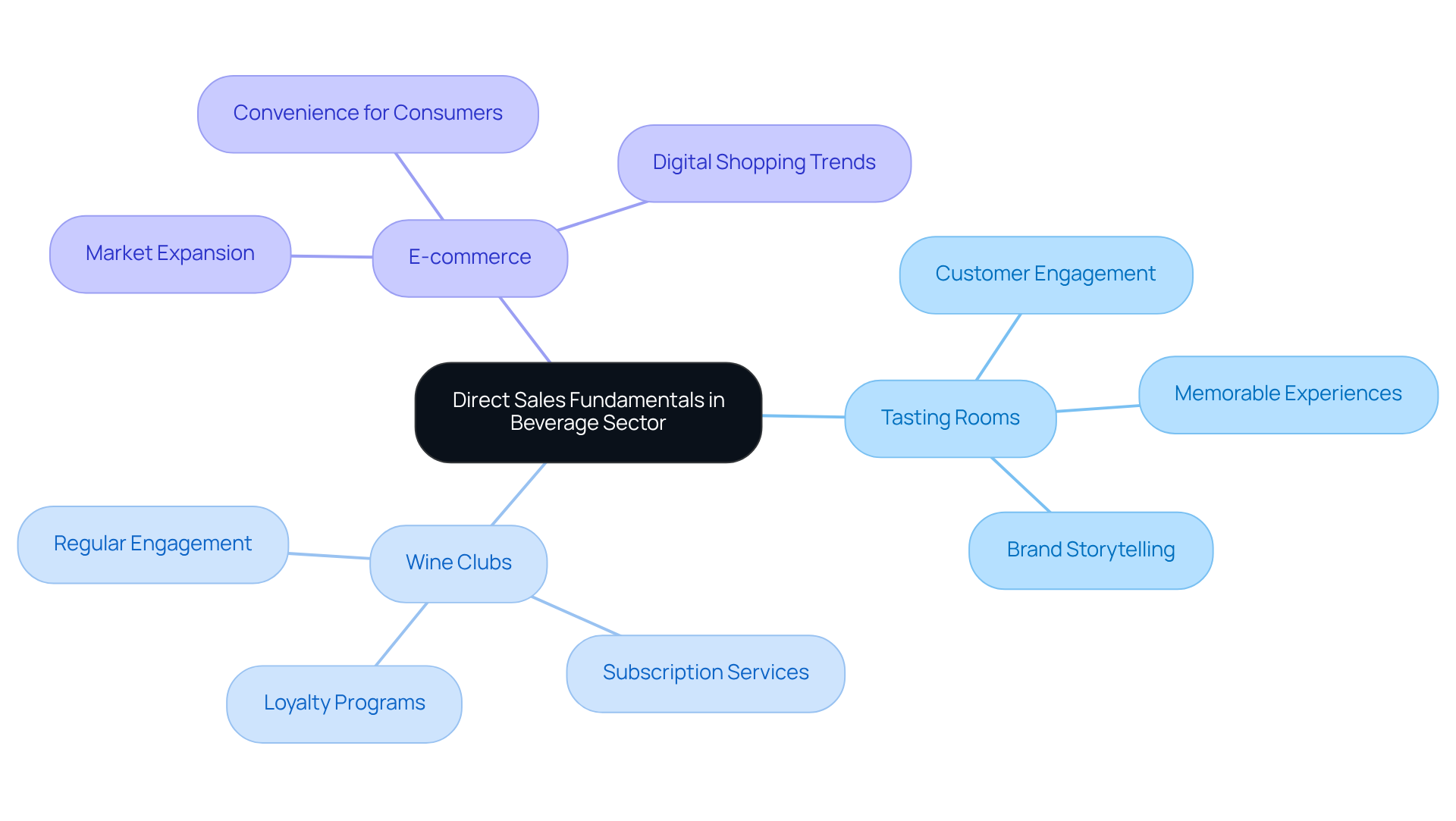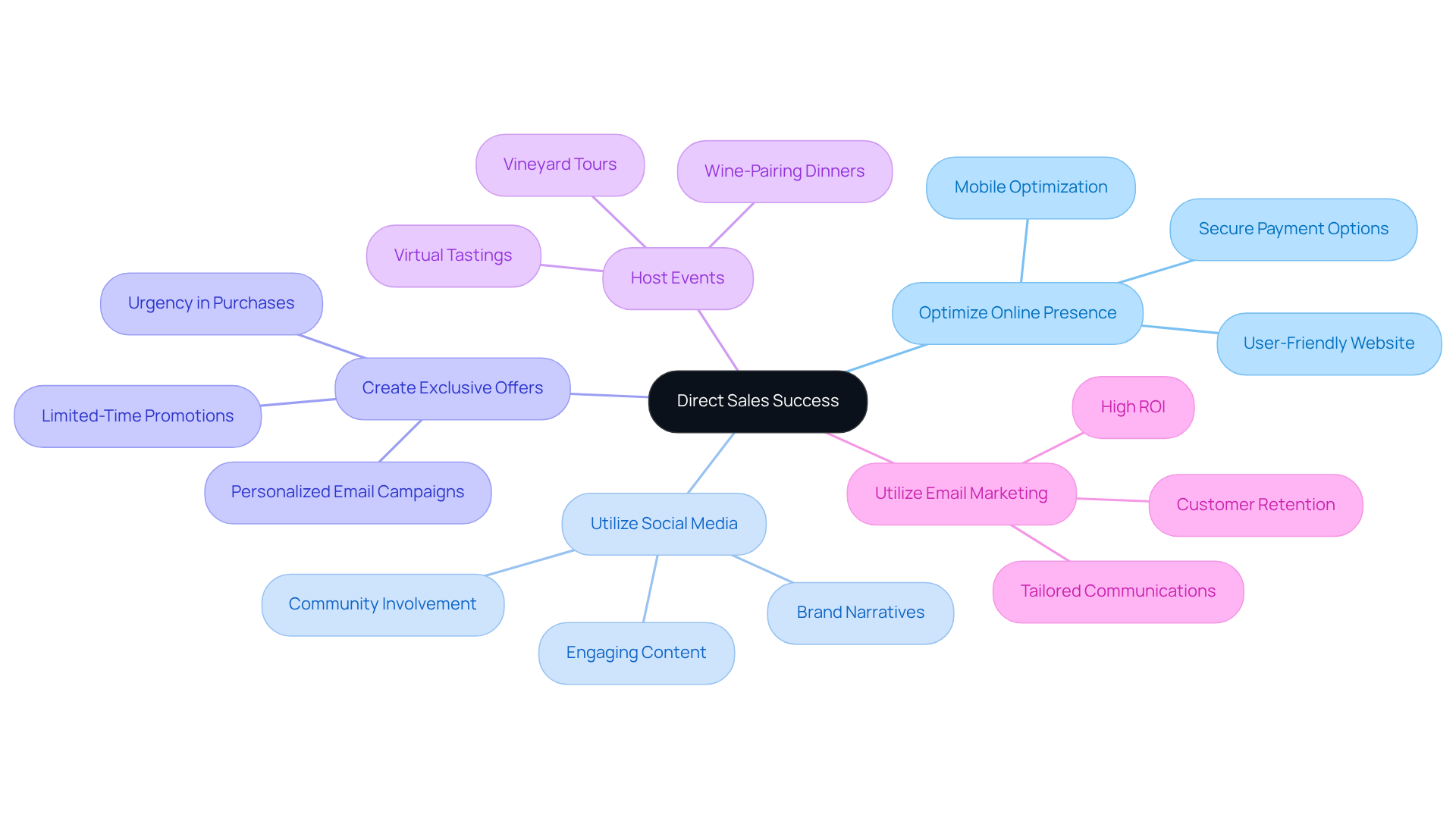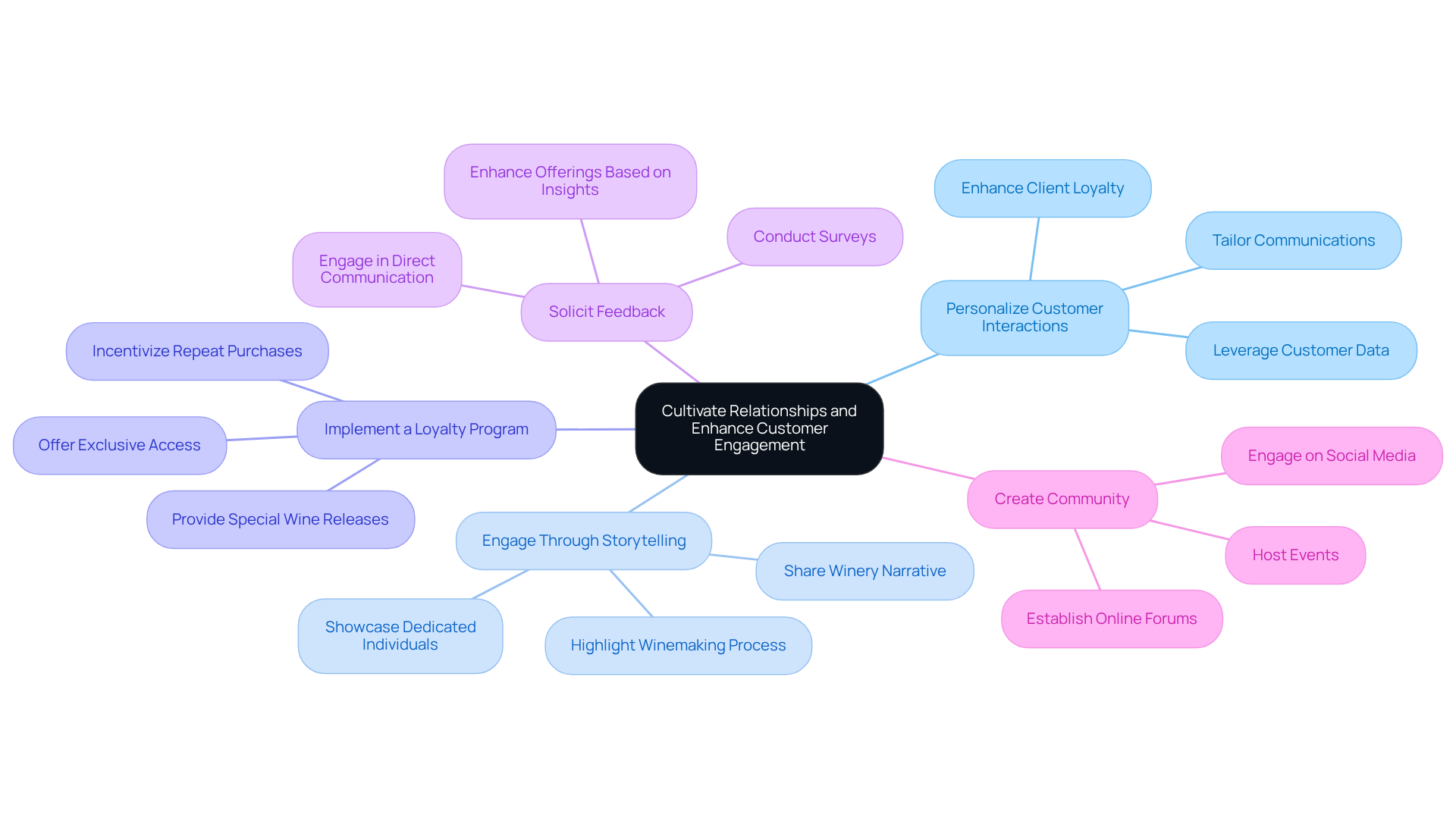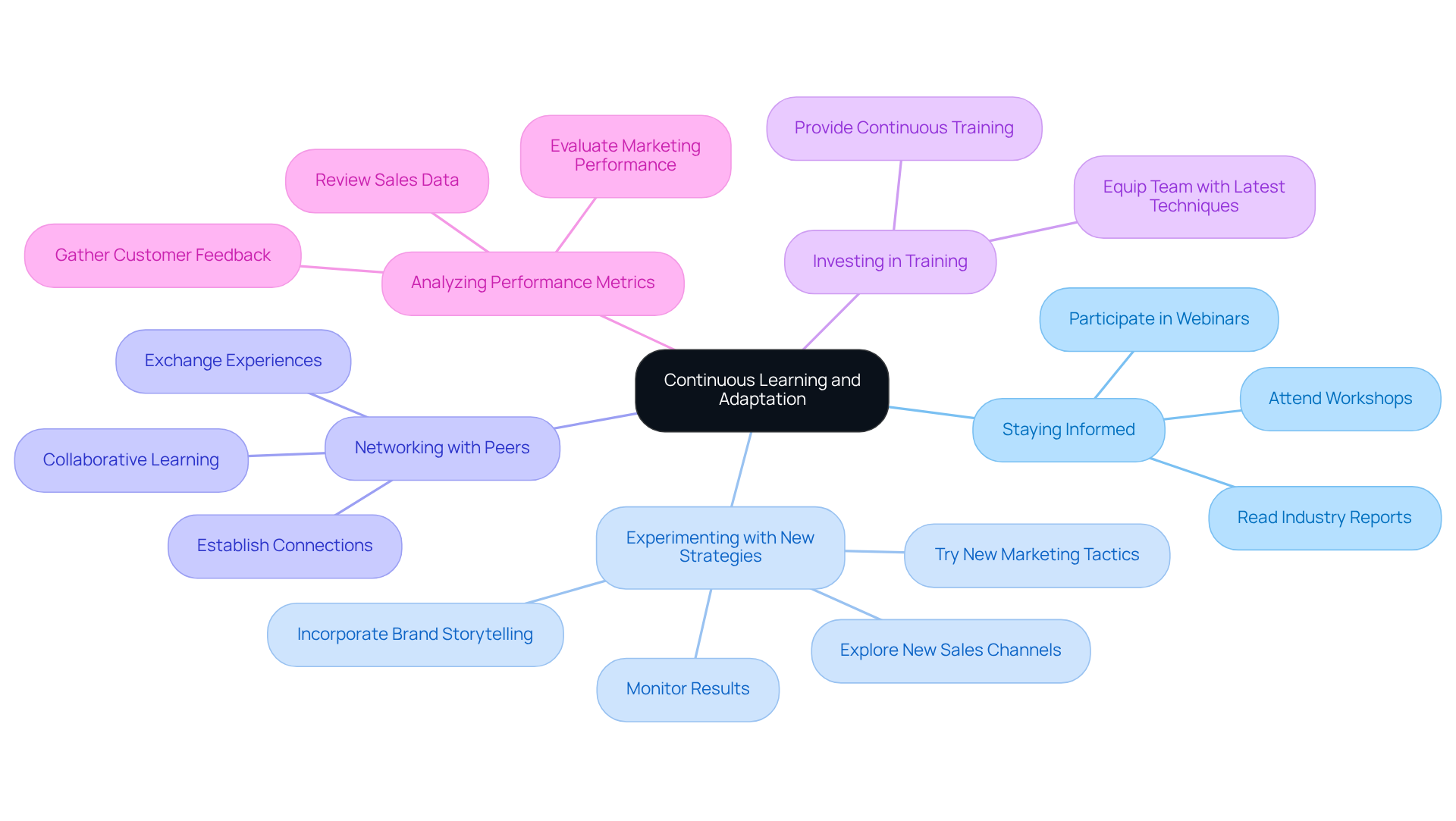Overview
Direct sales are essential for a winery's success, thriving through strategic approaches that include:
- Optimizing online presence
- Engaging effectively via social media
- Crafting memorable customer experiences
To truly excel in direct sales, it is imperative to foster customer loyalty through:
- Personalized interactions
- Compelling storytelling
Additionally, continuous adaptation to market trends enhances brand connection and profitability. By implementing these strategies, wineries can not only strengthen their market position but also cultivate lasting relationships with their customers.
Introduction
In the competitive landscape of the beverage industry, wineries confront the dual challenge of maximizing profits while forging meaningful connections with consumers. Direct sales emerge as a powerful strategy, enabling wineries to bypass intermediaries and engage clients directly, thereby enhancing brand loyalty and profitability. However, as market dynamics shift and consumer behaviors evolve, the pressing question arises: how can wineries effectively harness the potential of direct sales to not only survive but thrive?
Understand Direct Sales Fundamentals
In the beverage sector, direct sales thrive as a pivotal strategy, allowing businesses to offer products directly to customers and circumvent middlemen. This approach not only enables wineries to retain a larger share of profits but also fosters direct connections with clients, thereby enhancing brand loyalty. The key components of successful direct sales are as follows:
- Tasting Rooms: These physical locations act as essential touchpoints where customers can sample and purchase wines. They play a crucial role in ensuring that direct sales thrive and in creating memorable experiences that encourage repeat visits, particularly when compelling brand stories are woven into these spaces.
- [Wine clubs are instrumental](https://sovos.com/shipcompliant/content-library/wine-dtc-report) in cultivating loyalty and ensuring consistent revenue streams, as they enable direct sales to thrive by delivering wines directly to consumers through subscription services. They allow vintners to engage with their clients regularly, strengthening brand ties and transforming casual purchasers into devoted club members.
- E-commerce: Online platforms have become indispensable for reaching consumers, especially as the trend towards digital shopping continues to accelerate. E-commerce empowers vineyards to expand their market reach and cater to the convenience-oriented consumer.
In 2025, the need for vineyards to adapt to evolving market dynamics highlights how direct sales thrive in the importance of direct-to-consumer transactions. Despite a reported decrease of 2.1 percent in direct-to-consumer transactions across the U.S. in 2023, successful vineyards illustrate how direct sales thrive through innovative strategies. For example, the implementation of variable tasting fees has attracted new consumers during slower periods, while tailored offerings have revitalized visitation during off-peak times.
Understanding these fundamentals is crucial for businesses aiming for . By leveraging tasting rooms, wine clubs, and online commerce, alongside strategic capital planning, producers can devise effective marketing strategies that not only generate immediate income but also cultivate long-term loyalty and sustainability.

Implement Key Strategies for Direct Sales Success
To achieve direct sales success, wineries must implement key strategies that command attention and drive results:
- Optimize Your Online Presence: A user-friendly, mobile-optimized website with secure payment options is essential for converting visitors into customers. With over 55% of global website traffic originating from mobile devices, ensuring a significantly enhances user engagement and sales.
- Utilize Social Media: Platforms such as Instagram and Facebook are critical for showcasing beverages and sharing brand narratives. Consistently sharing visually appealing content not only attracts prospective clients but also fosters community involvement. Engaging content across social platforms can drive traffic to your website, indirectly improving search rankings and brand visibility.
- Create Exclusive Offers: Developing limited-time promotions or exclusive wine releases for wine club members generates urgency and encourages purchases. Personalized email campaigns can deliver six times higher transaction rates, making targeted offers particularly effective.
- Host Events: Organizing virtual tastings, vineyard tours, or wine-pairing dinners creates memorable experiences that cultivate loyalty. High turnout and positive feedback from such events underscore effective experiential marketing strategies, strengthening relationships with clients.
- Utilize Email Marketing: Building a robust email list allows vineyards to send tailored communications, keeping patrons informed about new releases, events, and promotions. Every $1 invested in email marketing can yield approximately $36 in return, establishing it as a powerful tool for boosting revenue.
By employing these strategies, vineyards can effectively harness the power of social media and direct interaction to ensure that direct sales thrive while forging lasting connections with clients.

Cultivate Relationships and Enhance Customer Engagement
To cultivate relationships and enhance customer engagement, wineries must take strategic actions:
- Personalize Customer Interactions: Leverage customer data to tailor communications and offers according to individual preferences and purchase history. This personal touch can significantly enhance client loyalty and ensure that direct sales thrive.
- Engage Through Storytelling: Share the compelling narrative behind your winery, the intricacies of the winemaking process, and the dedicated individuals involved. Genuine storytelling not only fosters emotional connections with clients but also fortifies your brand identity, making it more memorable and relatable.
- Implement a Loyalty Program: Create a rewards program that incentivizes repeat purchases and referrals. This could encompass discounts, exclusive access to events, or special wine releases, fostering a deeper connection with your brand and allowing direct sales to thrive.
- Solicit Feedback: Regularly seek input from clients through surveys or direct communication. This practice not only demonstrates your appreciation for their viewpoints but also provides valuable insights for enhancing your offerings and aligning them with client expectations.
- Create Community: Cultivate a sense of belonging among your clients by hosting events, establishing online forums, or engaging with them on social media. Building a devoted clientele that feels connected to your brand is crucial for sustained success, particularly in the competitive wine sector. Furthermore, strategic capital planning can bolster these initiatives by ensuring that resources are allocated effectively to enhance customer engagement and drive growth.

Embrace Continuous Learning and Adaptation
Wineries must prioritize to thrive in a competitive landscape. This commitment can be achieved through several strategic approaches:
- Staying Informed: It is imperative to regularly read industry reports, attend workshops, and participate in webinars. This practice keeps you updated on market trends and consumer preferences, particularly on how direct sales thrive in direct-to-consumer sales strategies.
- Experimenting with New Strategies: Embrace the opportunity to try new marketing tactics, sales channels, or product offerings. Incorporating brand storytelling can effectively engage patrons, transforming casual buyers into loyal club members. Monitor the results meticulously and adjust your approach based on what proves most effective.
- Networking with Peers: Establish connections with fellow vineyard proprietors and industry specialists to exchange experiences, challenges, and solutions. Collaborative learning can foster innovative ideas and best practices, particularly in strategic capital planning for growth opportunities.
- Investing in Training: Provide continuous training for your team to ensure they are equipped with the latest techniques and service skills. An informed team significantly enhances the client experience and ensures that direct sales thrive in the vineyard's direct-to-consumer efforts.
- Analyzing Performance Metrics: Regularly review sales data, customer feedback, and marketing performance to pinpoint areas for improvement. Utilize this data to inform future strategies and decisions, ensuring alignment with your winery's growth objectives and capital planning.

Conclusion
Direct sales represent a cornerstone for the success of wineries, enabling a direct connection with customers while maximizing profit margins. This strategy not only enhances brand loyalty but also allows wineries to craft unique experiences that resonate with consumers. By focusing on key elements such as tasting rooms, wine clubs, and e-commerce, wineries can effectively engage their audience and ensure sustainable growth.
The article delineates several critical strategies for achieving success in direct sales:
- Optimizing online presence
- Utilizing social media
- Creating exclusive offers
- Hosting events
These tactics are meticulously designed to foster customer engagement and loyalty. Personalization and storytelling play significant roles in building lasting connections with clients, while continuous learning and adaptation remain essential for navigating the ever-evolving market landscape.
Ultimately, the path to thriving direct sales in the wine industry is paved with innovation, genuine connections, and a steadfast commitment to understanding consumer needs. Wineries are encouraged to embrace these strategies and cultivate relationships that not only drive immediate sales but also ensure long-term success in a competitive environment. By doing so, they can transform casual buyers into devoted patrons, thereby securing a bright future for their businesses.
Frequently Asked Questions
What is the primary strategy of direct sales in the beverage sector?
Direct sales in the beverage sector allow businesses to offer products directly to customers, bypassing middlemen, which helps wineries retain a larger share of profits and fosters direct connections with clients.
What role do tasting rooms play in direct sales?
Tasting rooms serve as essential touchpoints where customers can sample and purchase wines, creating memorable experiences that encourage repeat visits, especially when compelling brand stories are incorporated.
How do wine clubs contribute to direct sales?
Wine clubs cultivate customer loyalty and ensure consistent revenue by delivering wines directly to consumers through subscription services, allowing vintners to engage regularly with clients and transform casual purchasers into devoted members.
Why is e-commerce important for vineyards?
E-commerce platforms are crucial for reaching consumers, especially as digital shopping trends increase, allowing vineyards to expand their market reach and cater to convenience-oriented consumers.
What challenges did direct-to-consumer transactions face in 2023?
In 2023, there was a reported decrease of 2.1 percent in direct-to-consumer transactions across the U.S., highlighting the need for vineyards to adapt to evolving market dynamics.
What innovative strategies have successful vineyards implemented to enhance direct sales?
Successful vineyards have introduced variable tasting fees to attract new consumers during slower periods and tailored offerings to revitalize visitation during off-peak times.
What are the key components for success in direct sales for businesses?
Key components for success in direct sales include leveraging tasting rooms, wine clubs, e-commerce, and strategic capital planning to devise effective marketing strategies that generate immediate income and foster long-term loyalty.




